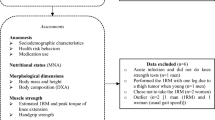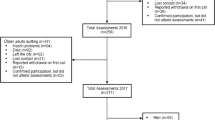Abstract
OBJECTIVES: The aim of the present study was to test the association between muscular strength, functional limitations, body composition measurements and indexes of sarcopenia in a sample of community-dwelling, elderly women at the high end of the functional spectrum.
DESIGN: Cross-sectional.
SUBJECTS: In all, 167 women aged 67–78 y were selected from the general population in central Verona. A group of 120 premenopausal healthy women aged 20–50 y represented the young reference group.
MEASUREMENTS: Body weight, height, body mass index (BMI) and the presence of acute and chronic conditions were evaluated in each subject. Body composition was measured by dual-energy X-ray absorptiometry (DXA). Physical functioning was assessed using a modified version of the Activities of Daily Living Scale. Dominant leg isometric strength was measured with a Spark Handheld Dynamometer.
RESULTS: Elderly women with BMI higher than 30 kg/m2 and in the highest quintile of body fat percent showed a significantly higher prevalence of functional limitation. In our population study, about 40% of sarcopenic elderly women and 50% of elderly women with high body fat and normal muscle mass were functionally limited. The prevalence of functional limitation significantly increased in subjects with class II sarcopenia, defined according to the skeletal muscle mass index (SMI=skeletal muscle mass/body mass × 100). In logistic regression models, after adjusting for age and different chronic health conditions, subjects with BMI higher than 30 kg/m2, in the highest quintile of body fat, or with high body fat and normal muscle mass or class II sarcopenia according to SMI, had a 3–4 times increased risk of functional limitations. Finally, isometric leg strength was significantly lower in subjects in the lowest quintile of relative muscle mass and in sarcopenic and sarcopenic obese women.
CONCLUSIONS: High body fat and high BMI values were associated with a greater probability of functional limitation in a population of elderly women at the high end of the functional spectrum. Among the different indexes of sarcopenia used in this study, only SMI predicted functional impairment and disability. Isometric leg strength was significantly lower in subjects with sarcopenia and sarcopenic obesity.
This is a preview of subscription content, access via your institution
Access options
Subscribe to this journal
Receive 12 print issues and online access
$259.00 per year
only $21.58 per issue
Buy this article
- Purchase on Springer Link
- Instant access to full article PDF
Prices may be subject to local taxes which are calculated during checkout

Similar content being viewed by others
References
Rosenberg IH . Summary comments: epidemiological and methodological problems in determining nutritional status of older persons. Am J Clin Nutr 1989; 50: 1231–1233.
Morley JE, Baumgartmer RN, Roubenoff R, Mayer J, Nair KS . From the Chicago Meetings. Sarcopenia. J Lab Clin Med 2001; 137: 231–243.
Barazzoni R, Nair KS . Session on protein metabolism in the elderly. Sarcopenia of the elderly. Diabetes Nutr Metab 2000; 13: 92–98.
Roubenoff R, Hughes VA . Sarcopenia: current concepts. J Gerontol A Biol Sci Med Sci 2000; 12: M716–M724.
Roubenoff R, Heymsfield SB, Kehayias JJ, Cannon JG, Rosenberg IH . Standardization of nomenclature of body composition in weight loss. Am J Clin Nutr 1997; 66: 192–196.
Roubenoff R . Sarcopenia and its implications for the elderly. Eur J Clin Nutr 2000; 54: S40–S47.
Baumgartner RN, Koehler KM, Gallagher D, Romero L, Heymsfield SB, Ross RR, Garry PJ, Lindeman RD . Epidemiology of sarcopenia among the elderly in New Mexico. Am J Epidemiol 1998; 147: 755–763.
Melton LJ, Khosla S, Crowson CS, O'Connor MK, O'Fallon WM, Riggs BL . Epidemiology of sarcopenia. J Am Geriatr Soc 2000; 48: 625–630.
Tanko LB, Movsesyan L, Mouritzen U, Christiansen C, Svendsen OL . Appendicular lean tissue mass and the prevalence of sarcopenia among healthy women. Metabolism 2002; 51: 69–74.
Schutz Y, Kyle UUG, Pichard C . Fat-free mass index and fat mass index percentiles in Caucasian aged 18–98 y. Int J Obesity 2002; 26: 953–960.
Janssen I, Heymsfield SB, Ross R . Low relative skeletal muscle mass (sarcopenia) in older persons is associated with functional impairment and physical disability. J Am Geriatr Soc 2002; 50: 889–896.
Visser M, Kritchevsky SB, Goodpaster BH, Newman AB, Nevitt M, Stamm E, Harris TB . Leg muscle mass and composition in relation to lower extremity performance in men and women aged 70 to 79: the Health, Aging and Body Composition Study. JAGS 2002; 50: 897–904.
Visser M, Harris TB, Langlois J, Hannan MT, Roubenoff R, Felson DT, Wilson PWF, Kiel DP . Body fat and skeletal muscle mass in relation to physical disability in very old men and women of the Framingham Hearth Study. J Gerontol 1998; 53A: M214–M221.
Visser M, Langlois J, Guralnik JM, Culey JA, Kronmal RA, Robbins J, Williamson JD, Harris TB . High body fatness, but not low fat-free mass, predicts disability in older men and women: Cardiovascular Health Study. Am J Clin Nutr 1998; 68: 584–590.
Sternfeld B, Ngo L, Satariano WA, Tager IB . Associations of body composition with physical performance and self-reported functional limitation in elderly men and women. Am J Epidemiol 2002; 156: 110–121.
Zamboni M, Turcato E, Santana H, Maggi S, Harris TB, Pietrobelli A, Heymsfield SB . The relationship between body composition and physical performance in older women. J Am Geriatr Soc 1999; 47: 1403–1408.
Launer LJ, Harris T, Rumpel C, Madans J . Body mass index, weight change, and risk of mobility disability in middle-aged and older women. JAMA 1994; 271: 1093–1098.
Coakley EH, Kawaki I, Manson JE, Speizer FE, Willet WC, Colditz GA . Lower levels of physical functioning are associated with higher body weight among middle-aged and older women. Int J Obes 1998; 22: 958–965.
Friedmann JM, Elasy T, Jensen GL . The relationship between body mass index and self-reported functional limitation among older adults: a gender difference. J Am Geriatr Soc 2001; 49: 398–403.
Jensen GL, Friedmann JM . Obesity is associated with functional decline in community-dwelling rural older persons. J Am Geriatr Soc 2002; 50: 918–923.
Nair KS . Age-related changes in muscle. Mayo Clinic Proc 2000; 75: S14–S18.
Gallagher D, Visser M, De Meersman RE, Sepulveda D, Baumgartner RN, Pierson RN, Harris T, Heymsfield SB . Appendicular skeletal muscle mass: effects of age, gender, and ethnicity. J Appl Physiol 1997; 83: 229–239.
Baumgartner RN, Stauber PM, McHugh D, Koehler KM, Garry PJ . Cross-sectional age differences in body composition in persons 60+ years of age. J Gerontol 1995; 50: M307–M316.
Kehayias JJ, Fiatarone MA, Zhuang H, Roubenoff R . Total body potassium and body fat: relevance to aging. Am J Clin Nutr 1997; 66: 904–910.
The Italian Longitudinal Study on Aging Working Group. Prevalence of chronic diseases in older Italians: comparing self-reported and clinical diagnoses. Int J Epidemiol 1997; 26: 995–1002.
Langlois JA, Maggi S, Harris T, Simonsick EM, Ferrucci L, Pavan M, Sartori L, Enzi G . Self-report of difficulty in performing functional activities identifies a broad range of disability in old age. J Am Geriatr Soc. 1996; 44: 1421–1428.
Katz SC, Ford AB, Moskovitz RW . Studies of illness in the aged. The Index of ADL: a standardized measure of biological and psychosocial function. JAMA 1963; 185: 914–919.
Rosow I, Breslau N . A Guttman health scale for the aged. J Gerontol 1966; 21: 556–559.
Lawton MP, Brody EM . Assessment of older people: self-maintaining and instrumental activities of daily living. J Gerontol 1982; 37: 91–99.
Mazess RB, Barden HS, Bisek JP, Hanson J . Dual-energy X-ray absorptiometry for total-body and regional bone-mineral and soft-tissue composition. Am J Clin Nutr 1990; 51: 1106–1112.
Pietrobelli A, Formica C, Wang Z, Heymsfield SB . Dual-energy X-ray absorptiometry body composition model: review of physical concepts. Am J Physiol 1996; 271: E941–E951.
Heymsfield SB, Smith R, Aulet M, Bensen B, Lichtman S, Wang J, Pierson RN . Appendicular skeletal muscle mass: measurement by dual-photon absorptiometry. Am J Clin Nutr 1990; 52: 214–218.
Kim J, Wang Z, Heymsfield SB, Baumgartner RN, Gallagher D . Total-body skeletal muscle mass: estimation by a new dual-energy X-ray absorptiometry method. Am J Clin Nutr 2002; 76: 378–383.
Davison KK, Ford ES, Cogswell ME, Dietz WH . Percentage of body fat and body mass index are associated with mobility limitations in people aged 70 and older from NHANES III. J Am Geriatr Soc 2002; 50: 1802–1809.
World Health Organization. Obesity. Preventing and managing the global epidemic. Report of a WHO consultation on obesity World Health Organization: Geneva, Switzerland; 1998.
Fried LP, Guralnik JM . Disability in older adults: evidence regarding significance, etiology, and risk. J Am Geriatr Soc 1997; 45: 92–100.
Harris TB . Invited commentary: body composition in studies of aging: new opportunities to better understand health risks associated with weight. Am J Epidemiol 2002; 156: 122–124.
Baumgartner R . Body composition in healthy aging. In: Yasumura S, Wang J, Pierson RNJ (eds). Annals of the New York Academy of Sciences: In vivo Body Composition Studies. New York Academy of Sciences: New York, NY; 2000. pp 437–444.
Acknowledgements
This study was supported by grants from the MURST Project 2001 – prot. 2001065883_004.
Author information
Authors and Affiliations
Corresponding author
Rights and permissions
About this article
Cite this article
Zoico, E., Di Francesco, V., Guralnik, J. et al. Physical disability and muscular strength in relation to obesity and different body composition indexes in a sample of healthy elderly women. Int J Obes 28, 234–241 (2004). https://doi.org/10.1038/sj.ijo.0802552
Received:
Revised:
Accepted:
Published:
Issue Date:
DOI: https://doi.org/10.1038/sj.ijo.0802552
Keywords
This article is cited by
-
The objectively measured walking speed and risk of hypertension in Chinese older adults: a prospective cohort study
Hypertension Research (2023)
-
Developmental programming–ageing effects in muscle strength of obese rat offspring in a sex-dependent manner
Journal of Biosciences (2023)
-
Definition of an adapted cut-off for determining low lean tissue mass in older women with obesity: a comparison to current cut-offs
Scientific Reports (2022)
-
Effects of resistance training on body recomposition, muscular strength, and phase angle in older women with different fat mass levels
Aging Clinical and Experimental Research (2022)
-
Official Position of the Brazilian Association of Bone Assessment and Metabolism (ABRASSO) on the evaluation of body composition by densitometry—part II (clinical aspects): interpretation, reporting, and special situations
Advances in Rheumatology (2022)



